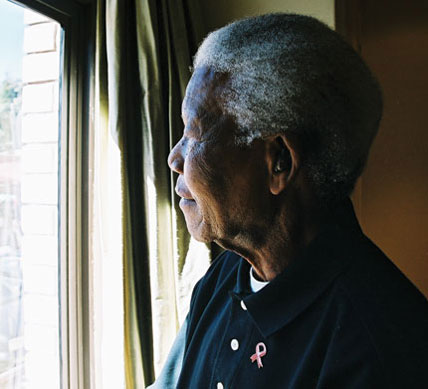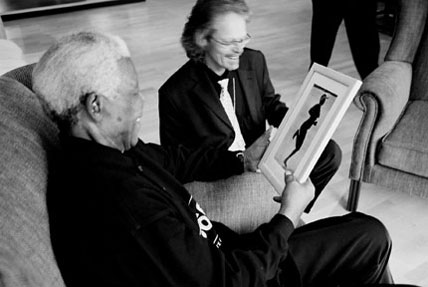The 'New South Africa'
The 'New South Africa' was heralded by the release from prison of Nelson Mandela on 11 February 1990, given formal expression by the country's first democratic election on 27 April 1994, and zenith during the presidency of Mandela in the period 1994-1999.
It was always a construct, a vision, embraced first in public discourses in South Africa and then quickly adopted globally as shorthand for the ambitious project of democratisation rising from the wreckage of over four decades of apartheid rule. But it was also the signature for intense and wide-ranging work designed to reconstruct and develop a society shattered by oppression.
From the outset the vision relied on a combination of legend and symbol to give it shape and to stretch its reach. Public discourse in and about South Africa was emblazoned by the concepts of noble struggle against apartheid, of post-apartheid reconciliation, and of nation-building. Central to this energy was the life and work of Nelson Mandela, the living symbol of Archbishop Desmond Tutu's 'rainbow nation'.
Of course, vision devoid of memory and hard work is doomed to failure. Through the 1990s and into the new millennium, South Africa received praise from around the world for the way in which it sought to deal with its oppressive past. Its post-apartheid governments insisted on the making of a future through intense engagement with memory of the colonial and apartheid eras. Memory work ranged from the endeavour of the Truth and Reconciliation Commission (TRC) to the flowering of new museums and archives, from the investigations underpinning the land restitution process to the writing of new histories for schoolchildren, from the research supporting special pensions and the location of missing persons to the use of freedom of information instruments by civil society. The symbolic moment representing all this work was Archbishop Tutu handing the report of the TRC to President Mandela in 1998.
Unravelling and loss
While the resilience of apartheid social patterning and the daunting challenges facing basic public service delivery were only too evident by the time Mandela stepped down as president in 1999, the dream of a 'rainbow nation' seemed realizable in a not-toodistant future. Nine years later, the dream is shattered. Widespread violence directed at foreign nationals who have sought sanctuary in the country has destroyed any notion of South Africa as an illuminated terrain of hospitality.
As we search for a sustainable solution to what is an intractable problem, we are confronted by a range of other deep-rooted and more or less related social ills: a still-rampant HIV/AIDS pandemic, unacceptably high rates of crime, levels of poverty seemingly impervious to the best endeavours of reconstruction and development, corruption, an economy under severe strain, creaking service delivery infrastructures, skills shortages compounded by brain drain, neighbouring Zimbabwe imploding, an absence of social cohesion, and a failure of leadership at many levels.
In these contexts the legends which have nurtured the 'New South Africa' are, at best, wearing thin, and at worst, unravelling. It is clear now that reconciliation is in its earliest stage of realisation. Liberation has reached too small a number of South Africans to be an enduring energy of unification. The notion of a South Africa belonging to all who live in it seems impossibly idealistic. And it is now abundantly clear that our post-1990 memory work has been too superficial. Even the much-vaunted TRC only scratched the surface of the country's pain and alienation. The really hard work, the work which will truly embrace damage and offer healing, remains to be done.
Nelson Mandela's legacy
What does all this mean for the legacy of Nelson Mandela? Where does this leave the liberatory work of his long life? How do we act upon his injunction, delivered in London in June 2008, to embrace the notion that 'it is now in the hands of your generation'?
Two preliminary propositions. Firstly, legacies are never received; they are only ever made and re-made. Of course, this would require an extended analysis to substantiate. Suffice it to acknowledge that it flows from a deconstructive frame, and to quote Jacques Derrida briefly: 'To inherit is not essentially to receive something, a given that one could then have. It is an active affirmation; it responds to an injunction, but it also presupposes an initiative, the signature, or countersignature of a critical selection. To inherit is to select, to sort, to highlight, to reactivate... There is legacy only where assignations are multiple and contradictory, secret enough to defy interpretation, to carry the unlimited risk of active interpretation. It is here that a decision and a responsibility can be taken.'
'For any organisation claiming a stake in the legacy of Nelson Mandela, including the Nelson Mandela Foundation, such an understanding removes the terrible burden of attempting to preserve and promote 'the legacy'. At the same time, it poses the responsibility of 'the signature, or countersignature of a critical selection.'
The legends which
have nurtured the
'New South Africa'
are, at best, wearing
thin, and at worst,
unravelling.



